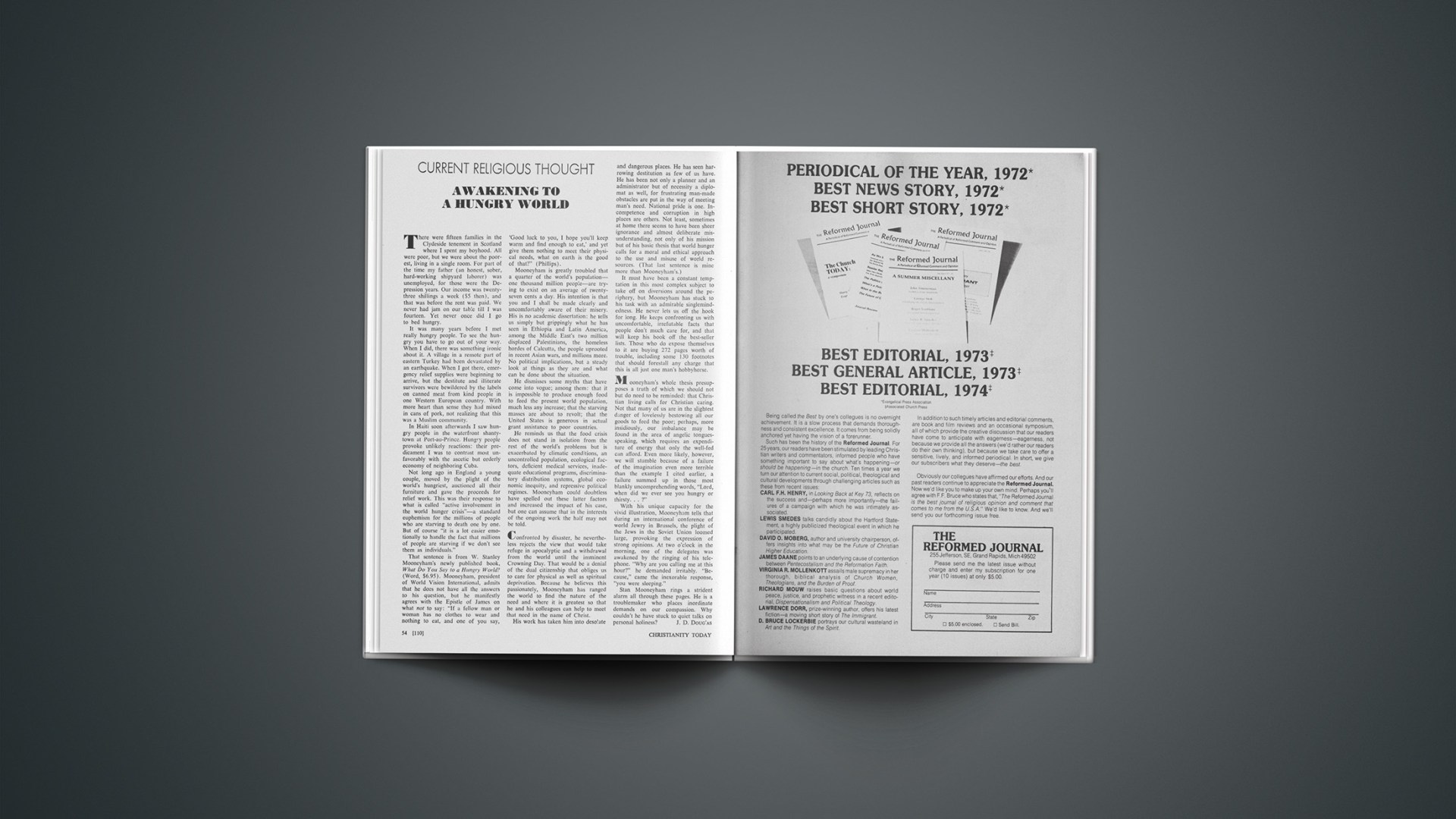From the rubble of the Haight-Ashbury district in San Francisco and the strung-out Sunset Strip in Los Angeles emerged hundreds of young people in the summer of 1967 who forsook drugs, free sex, occultism, and Eastern mysticism to follow Jesus.
Thus began the so-called Jesus movement, a descriptive virtually unknown until the late Look used it in a headline of a feature in its February 9, 1971, issue.
In the months that followed the 1967 spiritual explosion in the West Coast counterculture, vast numbers of young people across the land similarly embraced Christ. A love-hungry, peace-seeking generation had come home.
Much of the action took place outside of the churches, but young people in churches in scores of communities came alive too. They hit the streets and parks and beaches with guitars and Bibles in a prodigious outpouring of witness marked by its relevance to time and culture. There were Jesus-music concerts, underground-type Jesus tabloids, and Jesus witness marches. Coffeehouse and hot-line ministries flourished.
Then came all the press notice in 1971 and after that the fads, the era of buttons and bumper stickers and Jesus wristwatches. It was also a period when many churches and para-church organizations harnessed part of the movement—or became caught up in it. Campus Crusade’s Explo ’72 in Dallas, attended by 85,000, probably reflected both aspects.
Sometime in 1973 the press stopped talking about the Jesus movement. Many soon reached the conclusion that the movement had died.
Ironically, the movement in 1973 was thriving in eastern Ohio and western Pennsylvania, for example, where it was probably bigger numerically than it ever was in California. And it was booming overseas.
On the other hand, the movement as a whole was in the throes of transition, undergoing the same kind of changes affecting the overall youth scene. The trend was away from streets and into books, away from confrontation and toward contemplation. Among Christians there was less emphasis on outreach, more on worship and Bible study. Large segments of the movement disappeared behind closed doors, and some segments that failed to adapt to the times disappeared altogether.
How does the movement fare today, if indeed it survives at all? To find the answer, CHRISTIANITY TODAY revisited several of the movers and shakers of the early days of the movement.
Ted Wise. Hundreds, probably thousands, can trace their spiritual ancestry in Christ to this former sailmaker. Wise was one of the artistic beatniks who were squeezed out of San Francisco’s North Beach district by economic pressures. He and the others moved into the low-rent Haight-Ashbury neighborhood, where they became known as hippies and where they were joined by tens of thousands of young people in 1966 and 1967. Wise, in his late twenties at the time and beset by marital woes, became a Christian in 1966 after reading a stray Bible that belonged to one of his wife’s relatives. He and his wife began attending a Baptist church in suburban Mill Valley but retained their cultural identity and their friends in the hip scene. Within months, Wise had led his closest friends to Christ.
Wise and his friends became the first staffers of the first Christian coffeehouse in Haight-Ashbury, the Living Room, opened in 1967 by several evangelical ministers in the area. There were no salaries with the job, so the group worked at odd jobs to keep afloat. To help make ends meet they and their wives and children shared a large old house they dubbed the House of Acts—one of the first modern Christian house ministries. Hundreds of troubled persons found a temporary home at the House of Acts, and many of them also found Christ there.
In time, Haight-Ashbury changed, the coffeehouse was closed, and the group split up. Officials in a San Francisco suburb hired Wise to head a community anti-drug program. On the side he helped to direct youth outreach ministries.
For the past few years Wise has attended the Peninsula Bible Church in Palo Alto, where he assists with a postcollege singles group of 450 persons. He was a participant in last year’s congress on evangelization at Lausanne. His most intense wish is to become involved in full-time Christian work someday.
Ted Wise is representative of many of the early leaders of the Jesus movement: They still are turned on to Christ, they still have a strong inclination to be engaged in Christian service, they remain person-oriented in their concept of ministry, they have become identified with an organized church, and they are working hard to support their families.
Bob Smith, 60, one of Peninsula Bible Church’s pastors, says the Jesus people have made important contributions to church life. The most important is “a note of reality,” he states. A lot of traditional barriers have been broken down, he says, and the congregation is friendlier and better off spiritually for it.
Jack Sparks. One of the most colorful and effective Jesus-movement groups was the Christian World Liberation Front (CWLF). It was founded by Jack Sparks and a handful of fellow Campus Crusade for Christ staffers as a Crusade front in Berkeley in 1969. Disagreement arose almost immediately over Crusade’s policy requiring headquarters approval of published materials, and CWLF chose to become independent.
Sparks is a soft-spoken Ph.D. (statistics and research design) who taught at Penn State before joining Crusade. Under his direction CWLF became one of the best-known activist groups in Berkeley, speaking out on social issues, taking part in demonstrations, distributing stacks of literature, but always pointing to Christ in vigorous evangelistic appeals (see May 8, 1970, issue, page 40). Hundreds were converted through outreach efforts, and an ongoing program of group fellowship and Bible study was instituted for them. Dozens signed on as CWLF staffers.
One of CWLF’s productions was Right On, the first Jesus newspaper (see April 9, 1971, issue, page 38), and one of the few such papers still being published. In the beginning it was an outright evangelistic sheet, containing testimonies of converted dopers and radicals, mini sermons, and the like. Social issues and current affairs were touched on but not to the extent they are today. It has evolved into a top-quality thought publication that reflects the serious mood in the campus world. There are columns on the arts, interviews with name personalities, and controversial editorials on sticky questions. It has a paid circulation of 10,000, operates on a shoestring (its staff of college grads work at part-time jobs to augment their slice of the monthly payroll, which has never exceeded $500), and is edited by Sharon Gallagher. She is a Westmont College sociology graduate who studied at Regent College in Vancouver and under Francis Schaeffer at L’Abri in Switzerland.
Two months ago CWLF suffered a serious rupture. The CWLF fellowship had evolved into a house church of some seventy members under the direction of Sparks and Arnie Bernstein, a Jews for Jesus leader. At the same time, Sparks was also allied with other former Campus Crusade staffers who head shepherd-disciple type ministries with a heavy emphasis on authority. A clash occurred among Sparks’s house group in August on questions of authority, and half the group—including most of the CWLF staff—left the Sparks camp. (One issue: Some CWLFers wanted to attend other churches; Sparks declined to give permission.)
The upshot is that Sparks will concentrate on writing, house-church, and discipleship ministries. The CWLF name will not be used by either party. Sparks will be identified with the Fellowship of Renewal and Outreach. The dissidents will call themselves the Berkeley Christian Coalition, with Bill Squires as director. Squires was associated with CWLF from its beginning.
The coalition will publish Right On, sponsor The Crucible lecture and educational program, oversee a house ministry, and back the Spiritual Counterfeits Project (publication of materials on cults). A suit initiated by the latter against Transcendental Meditation teachings in public schools was pending in a California court this month.
The former Crusade staffers with whom Sparks is now “mutually committed” in an “apostolic band” are: Ken Berven of Seattle; Dick Ballew and Jon Braun of Santa Barbara, California; Peter Gillquist of Grand Junction, Tennessee; Ray Nethery of Mansfield, Ohio; and Gordon Walker of Nashville. The seven see themselves as apostles or missionaries called to set up and oversee small church groups patterned after biblical discipleship. Community, commitment, submission, and authority are recurring words in descriptions of the small groups. A chain of command already exists between the groups and the apostle-missionaries. This has led to the same kind of criticism as that leveled against Bob Mumford, Derek Prince, and others in the charismatic-oriented Christian Growth Ministries of Fort Lauderdale, Florida (see October 10 issue, page 52).
Chuck Smith. Nine years ago Calvary Chapel of Costa Mesa, California, had twenty-five members. By 1969 it had 150. Then it launched into an outreach program beamed at young people in the streets. Within two years attendance reached 2,000, hundreds at a time were being baptized in the ocean, building expansion programs could not keep abreast, and Look, Time, and network television reporters were knocking at the doors. Pastor Chuck Smith claimed he was not doing anything differently from before. Yet the throngs of young people kept coming.
Calvary Chapel today has 15,000 members. About 10,000 attend the three Sunday morning services. The majority of those in the congregation are under 35. The Sunday school is so crowded out that high schoolers are encouraged to attend a church service instead. The Saturday night youth meetings attract between 4,000 and 5,000, and 2,500 show up for Thursday night Bible-study meetings. Nearly 800 were baptized on a recent Monday night.
Smith dedicates fifteen babies every Sunday (five per service), and the waiting list is months long. The nursery has 200 cribs. A Christian day school through eighth grade has an enrollment of 630, and plans are moving ahead to build a high school.
There are no unpaid bills except for a mortgage of $300,000 on a mountain conference center (it will be paid off within a year). In fact, the church has a cash reserve of $350,000 (there are 5,000 tithers of record), and it owns $250,000 worth of television equipment. Calvary has started branch churches in other cities and Bible-study groups across the country, has built a $50,000 missionary radio station in Guatemala and is building another in El Salvador, and keeps a number of evangelistic music teams busy around the world.
The church has eight ministers (one is Smith’s son). Smith holds Foursquare Church ordination credentials, and he believes in Full Gospel doctrine, but Calvary’s church services are not charismatic oriented. There are only a few standard hymns or choruses (usually without instruments), no upraised hands, no tongues messages or prophecies, no “singing in the Spirit,” no shouted Amens. There is no choir (Smith says too many church troubles originate among choir members, and he thinks the entire congregation should be a choir). Nearly everyone brings a Bible, and many people take notes. Smith, 48, majors in verse-by-verse exposition, and his sermons last about forty-five minutes. He rarely gives up his pulpit to speak elsewhere.
Persons interviewed at random said they attend Calvary mainly because of Smith’s Bible teaching and partly because of the love they sense there.
Calvary Chapel has perhaps reaped more in sheer volume from the spiritual harvest of the Jesus movement than any other church. But, asserts Jesus-movement leader Carl Parks of Spokane (see January 29, 1971, issue, page 34), young people are as responsive to the Gospel as ever, and they will flock to churches where love, purpose, and clear Bible teaching abound—as many pastors besides Smith have discovered.
Parks, whose ministry has touched 3,000 youths, defines the Jesus movement as simply a revival that occurred in the youth culture, and he says there have been relatively few dropouts.
Undeniably, the movement has made an impact for good on the lives of many individuals, and a lot of churches are stronger for it. But with all the present-day emphasis on discipleship, community, and church activity in the apparent absence of new styles and strategies in evangelism, the current crop of teenagers might well ask: Whatever happened to the Jesus movement?
Morocco: Jabiri In Jail
A leading Moroccan Christian has been sent to prison for six months, because, police alleged, he broke the Muslim fast of Ramadan. The trial judge refused to accept the defense of Mustapha Jabiri, a telecommunications officer at the Casablanca airport. Jabiri contended that he has been a baptized Christian for more than five years and should therefore be exempt from a statute requiring all adult Muslims of the kingdom of Morocco to observe the Muslim fast. (During the month of Ramadan Muslims are prohibited from eating from early morning until night.) Jabiri was given the maximum sentence allowed.
Jabiri, in his early thirties, married, and the father of four small children, was a participant in last year’s evangelism congress at Lausanne. He reportedly was denounced to the police by a religion teacher with whom he had been having a private conversation concerning faith in Christ.
Some two hundred ex-Muslims in the 17-million-population nation have publicly witnessed their faith in Christ through baptism, says a mission source, and they practice this faith as openly as possible in a country which does not recognize legally their existence. Many more Moroccans might have openly claimed their Christian allegiance, says an observer, if the judge in the Jabiri case had upheld the right of a professed Christian to be exempt from Ramadan.
Earlier this year medical missionary William Campbell of Emmaus, Pennsylvania, and his family were expelled from Morocco for allegedly bribing two young Moroccans to become Christians. Campbell, 49, and his wife Holly (they have four children) were sentenced to a six-month prison term last September in connection with the charges, which Campbell labeled as false. The couple had remained free pending various appeals, including a final one to the national supreme court. In June they were suddenly expelled on two hours’ notice.
Campbell is associated with the Philadelphia-based North Africa Mission. For the past five years of his twenty years as a missionary in Morocco he was engaged in general practice in the central coastal city of Safi. The trouble started in 1973 when a group of townspeople accused Campbell of using his position to influence Muslim young people to change their faith. Religious freedom is ostensibly guaranteed under Moroccan law, but it is illegal for anyone to attempt to undermine a Muslim’s faith by taking advantage of “weakness or need,” or by using medical, educational, or orphanage auspices for such purposes. To do so is classified as seduction or bribery, punishable by up to three years in jail.
A young convert in Safi had gone to France in 1970 to attend a Bible school and a girl had gone to Tangier a year later to study nursing at the mission hospital there. The youths were not mentioned in the petition, but they were cited by the prosecution in the Campbell trial last year. The judge ruled Campbell had bribed them, even though no testimony was elicited from them.
Campbell states that he obeyed the law and did not use doctor-patient relationships as occasions for Christian witness. He and his wife meanwhile did host a Sunday morning meeting in their home for eight or so young Moroccan Christians. Last year the group of young people recorded on a tape cassette their greetings to a Campbell daughter studying in the United States. Authorities listened to the cassette at the post office, then arrested the Campbells on the proselytism and bribery charges. Under intense pressure from Campbell’s critics in Safi, national authorities apparently chose to deport the couple rather than to create an embarrassing international incident by jailing the Americans on religious charges. (U.S. aid to Morocco—it exceeded $33 million in fiscal 1973—has been declining in recent years; conceivably, such an incident could have made matters worse.)
The Morocco government last year nationalized the North African Mission hospital in Tangier. The mission closed several schools it operated. A government order officially banned missionaries, and a number of them left. The North Africa Mission and a Church of England mission agency, however, still have a low-profile presence in the country, and the Gospel Missionary Union has been getting better response than ever to radio broadcasts and Bible correspondence courses, according to a mission spokesman.
Compared to other Arab countries, says a mission source, Morocco has had an excellent record for its treatment of the once large Jewish minority, and there is still a Ministry of Rabbinic Affairs in Rabat. For Moroccan Christians, the case of Mustapha Jabiri highlights the need for constitutional changes which would allow national Christians the same freedom as Jews to practice their faith publicly and without fear.
Morocco signed the United Nations Universal Declaration of Human Rights that upholds among other things the freedom of religion and the right to hold and express opinions without interference. If that is so, a Moroccan believer might well wonder, why is Jabiri in jail?
GORDON FYLES and EDWARD E. PLOWMAN










